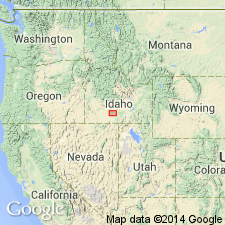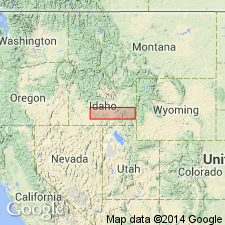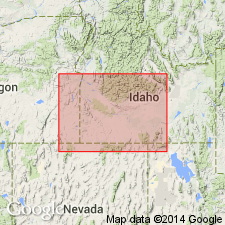
- Usage in publication:
-
- Thousand Springs basalt*
- Modifications:
-
- Named
- Dominant lithology:
-
- Basalt
- AAPG geologic province:
-
- Snake River basin
Summary:
Type locality: bluff above Thousand Springs, southwest of Wendell, Gooding Co, ID in the Snake River basin. Is a feldspar-olivine pahoehoe basalt 100+ ft thick. Is younger than Malad basalt; is older than McKinney basalt. Assigned to the Pleistocene.
Source: GNU records (USGS DDS-6; Denver GNULEX).

- Usage in publication:
-
- Thousand Springs basalt*
- Modifications:
-
- Overview
- AAPG geologic province:
-
- Snake River basin
Summary:
Forms rim rock of Snake River Canyon from Riley Springs, at southeast end of Hagerman Valley, to Sand Springs, Twin Falls Co, ID, Snake River basin. At Thousand Springs, unit consists of three flows of pahoehoe with feldspar phenocrysts up to 5 mm long. At all exposures, contact with underlying beds is characterized by development of comminuted glassy rock or pillow lava. Trail Butte, about 15 mi east of Thousand Springs near Jerome, Jerome Co, ID, may be source for basalt. Geologic maps; stratigraphic charts. Younger than Malad basalt; older than McKinney basalt. Assigned Pleistocene age.
Source: GNU records (USGS DDS-6; Denver GNULEX).

- Usage in publication:
-
- Thousand Springs Basalt*
- Modifications:
-
- Revised
- Overview
- AAPG geologic province:
-
- Snake River basin
Summary:
Assigned to Snake River Group as third from base of seven formations of Snake River Group (uppermost part of Snake River includes unnamed Recent lava flows). Malad Basalt now included as lower member of Thousand Springs and referred to as Malad Member. Malad included with Thousand Springs because units cannot be distinguished in upland plains east of Hagerman, though they are easily differentiated in exposures near Hagerman. Thousand Springs erupted from several vents; two known vents are Gooding Butte (near Gooding, ID) and Sonnickson Butte (near Jerome, ID). Thousand Springs fills former canyon of Snake River that was cut in stages as successive lava flows diverted river southward; thus, earliest lavas (Malad) are relatively high topographically near Hagerman and later lavas are lower south of Hagerman. Lava of Thousand Springs is fresh and ranges from olivine basalt to porphyritic plagioclase-olivine basalt. Unit is continuously exposed eastward along northern canyon rim of Snake River from Thousand Springs almost to Twin Falls, Gooding and Jerome Cos, Snake River basin. Maximum thickness 225 ft near Malad Canyon and 75 ft near Thousand Springs. Basalt is mainly columnar and highly permeable. Stratigraphic chart. Younger than Sugar Bowl Gravel (new); underlies Crowsnest Gravel (new). Freshwater mollusks found in alluvium on Malad suggest glacial age. Assigned late Pleistocene age.
Source: GNU records (USGS DDS-6; Denver GNULEX).
For more information, please contact Nancy Stamm, Geologic Names Committee Secretary.
Asterisk (*) indicates published by U.S. Geological Survey authors.
"No current usage" (†) implies that a name has been abandoned or has fallen into disuse. Former usage and, if known, replacement name given in parentheses ( ).
Slash (/) indicates name conflicts with nomenclatural guidelines (CSN, 1933; ACSN, 1961, 1970; NACSN, 1983, 2005, 2021). May be explained within brackets ([ ]).

